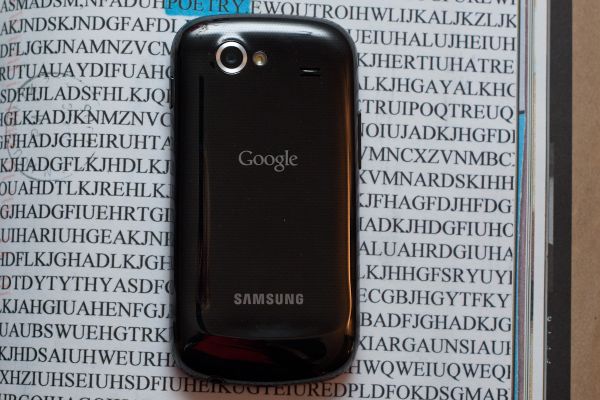Nexus S and Android 2.3 Review: Gingerbread for the Holidays
by Brian Klug on December 14, 2010 4:08 PM EST- Posted in
- Smartphones
- Samsung
- Nexus S
- Gingerbread
- Android 2.3
- Mobile
Conclusions and Final Thoughts
Right now, there's no doubt about it that the Nexus S is the best Android phone on the market, but that's almost purely a function of its status as the only Android device with Gingerbread at the moment. That isn't to say the hardware choices Google made with Samsung are bad, they're just a bit puzzling. Lacking external storage is hard to swallow for enthusiasts, even if the "USB Storage" partition works just like an SD card when connected over USB. Not having an HSPA+ baseband - even if it doesn't do much in terms of actual realizable speed at the moment, T-Mobile is already fast - is a checkbox feature that will give many pause as well. That said, the Nexus S does have notable extras that other phones lack such as the contour display and an NFC controller, but those aren't of immediate utility. NFC looks like something a number of other smartphone makers are going to get serious about supporting, and Google plans to quickly add support for P2P and card emulation modes. Using a smartphone as a hotel key, bus pass, or movie ticket sounds like something even I would've stuck firmly in the science-fiction category a decade ago, but that's what those modes will enable.
If the previous Nexus One was any indication, the real value from owning an actual google-branded phone is that you get updates first. Carriers and other vendors should take note - people want software updates, and fast. Promise quick platform updates, deliver them on the date you set, and you'll build some brand loyalty.
The Nexus name should always mean that the device is something of a rubric for other Android devices on the same software platform. It's the hardware the Android team will be carrying around when thinking about what changes to make to the platform, it's the device developers will likely use as a baseline reference design for performance and testing. Plus, it's stock Android - there's no T-Mobile branding, no HTC Sense, no carrier skins. Going forward, there's also going to be no moratorium on carrier-skinning with Gingerbread, so getting a device with pure unadulterated Android like the Nexus S really is a value-added proposition.
Going forward, I hope Google continues to make a Nexus device which represents their own pure vision of the smartphone space. The G1 served that purpose, then the Nexus One, now the Nexus S takes that role. I'm still waiting for that completely carrier-agnostic device with pentaband UMTS support and maybe some CDMA/EVDO goodness tossed in there, but that's likely a long ways off.
 Photo courtesy Sarah Trainor
Photo courtesy Sarah Trainor
I really feel like putting all my weight behing a total recommendation of the Nexus S would be easier were it not on T-Mobile alongside two equally competent, HSPA+ enabled, 45nm Snapdragon packing devices, namely the G2 (which also has stock Android) and the myTouch 4G. The 45nm Snapdragons with Adreno 205 GPUs have proven completely competent performers (and I'm not even finished testing the myTouch 4G yet), with Adreno 205 performing just shy of SGX 540, but worlds better than Adreno 200. If HSPA+ support really matters to you, even if it isn't the MIMO/Dual-Carrier variety that's going to make a huge difference quite yet, you're honestly better off getting one of those two phones and waiting the months (or however long it will be) before they see a Gingerbread build. If you want Gingerbread (and also awesome hardware) right now, get the Nexus S.
The other big question mark on the horizon is what dual-core SoCs from TI, Qualcomm, and NVIDIA will do to the smartphone landscape. It's possible that we'll see battery life improvements alongside another dramatic change in performance, but success all depends on how polished software, drivers, and the devices themselves are. It's a gamble for certain to wait and see what hardware will crop up at CES, but one month isn't very far away. For now however, the Nexus S is king of Android.











73 Comments
View All Comments
Zingam - Thursday, December 16, 2010 - link
I agree I have a nokia and the phone jack is on the top side. I have wished many times that it is on the bottomcece74 - Thursday, December 16, 2010 - link
I also miss the trackball on my Galaxy S.But I now use Swiftkey , a pretty good keyboard, and it also have arrow keys (press "123" then symbols : {&= key) to see it.
JimmiG - Thursday, December 16, 2010 - link
Basically a Galaxy S (which was basically a Nexus One with a better screen and faster GPU), with a few extra features, unlike the Nexus One which was pretty revolutionary for its time.Of course, the Nexus One isn't even a year old, which isn't such a long time.. but sometimes it feels like the N1 was released in another decade considering how fast things have moved. I hope the Nexus 3 or whatever at least as a dual-core out-of-order CPU and other improvements.
blueF - Thursday, December 16, 2010 - link
Well I purchased my Nexus S, and am very pleased with the phone. Scrolling is not as smooth as I was lead to believe, but still glad I purchased one.bobshute - Thursday, December 16, 2010 - link
Brian, are you sure on the 3G radio.The T-mobile Samsung Vibrant radio, although not advertised, is at least Quad band
It has the 1900 radio on by default for 3G on AT&T.
You can also turn on the 850 band in the service menu although it's not confirmed to work in 850 mhz only areas of AT&T coverage.
Voldenuit - Friday, December 17, 2010 - link
>Don't you usually have your phone in your pocket upside down anyway?Not if it's in the shirt pocket. Or jacket inner pocket. Or on a belt holster.
I'm a lot more likely to use a headphone with the phone in these places rather than in my pants pockets, where walking, sitting or standing up is more liable to crush/damage the headphone jack.
Inuit - Saturday, December 18, 2010 - link
A new on-screen keyboard for Android from Keypurr has directional keys, and it is in the main screen (no need to flip to another screen). I am using Keypurr on my Galaxy S - and love it!In addition, it has large keys (almost twice as large as the standard keyboard) and very clever and up-to-date dictionary. I can type on it as fast as hardware keyboard, or type one handed. It also comes in black or white skins, has function keys, and more. I think Keypurr has some good short videos on their site: www.keypurr.com
keypurrtech - Sunday, December 19, 2010 - link
Keypurr is a new Android keyboard that uses a full QWERTY layout with keys that are are almost twice the size of other onscreen QWERTY keyboards. It also has a dictionary that includes abbreviations, acronyms, and words borrowed from other languages. Best of all for Nexus S users (and anyone who's phone doesn't have a trackpad) it includes customizable function keys that can be used as directional controls.Keypurr allows users to type with greater speed, confidence, and ease, than any Android keyboard! Check out our website: www.keypurr.com or our youtube channel: www.youtube.com/keypurrtech to learn more.
teohhanhui - Monday, December 20, 2010 - link
"... people want carriers to provide first-party support for devices, and people want to play with devices in stores before making the jump ..."I wouldn't consider a carrier as the first party when it comes to providing support for phones (there is no doubt that they are the first party when it comes to network issues). As it stands, carriers are only worsening the experience by slapping on unwanted customizations and hindering roll-outs of OS updates.
What is stopping you from "playing with devices" in a retail store (either by manufacturer/OS vendor/authorized reseller)?
IMO the real reason for the prevalence of "carrier subsidies" seems to be consumers preferring to pay by installment, or simply unaware of the fact that they end up paying more in the end.
ravenfq - Tuesday, December 21, 2010 - link
I'm always disappointed to find that no reviewers mention the fact that Android doesn't support WiFi proxy 'out of the box' - any suggested solutions to this lack of functionality require that the user 'root' their device, which is not necessarily acceptable to everyone (for all sorts of reasons).This lack of functionality precludes student usage on campus, and crucially (in my opinion) any corporate in-house 'managed' usage, where any WiFI authentication is a pre-requisite.
As a CIO, I'm forced to eliminate Android-based devices from consideration as a corporate standard, and constrain my options to Apple, Microsoft and (hopefully) any upcoming HP WebOS-based devices.
This is deeply disappointing to me personally, as I applaud any attempt to separate the OS from the hardware, liberating hardware manufacturers to compete and innovate, and thus giving us, the end users, ever expanding and increasing capabilities in a portable device. I had high hopes for the relatively open Android environment in this regard.
I would also refer you to this (somewhat emotive) link that outlines the issue in more detail:
http://code.google.com/p/android/issues/detail?id=...
Thank you, Anandtech, for what is otherwise superb technical journalism.